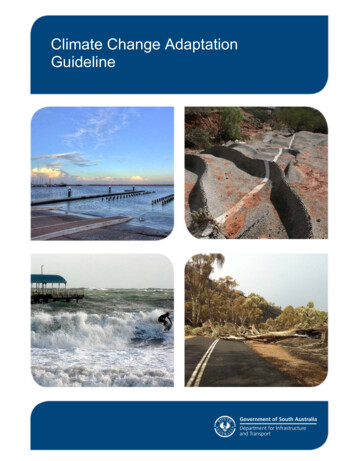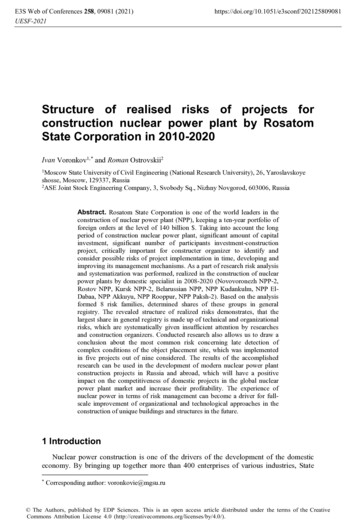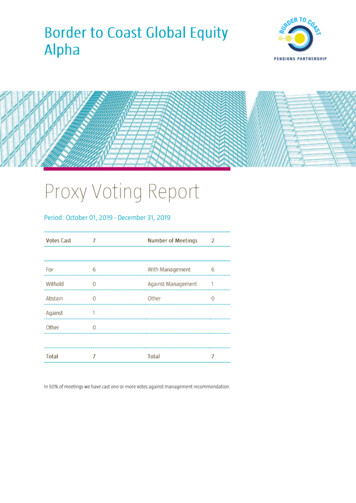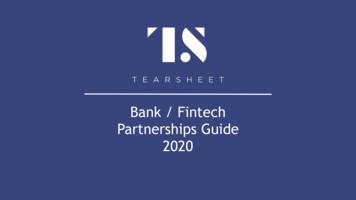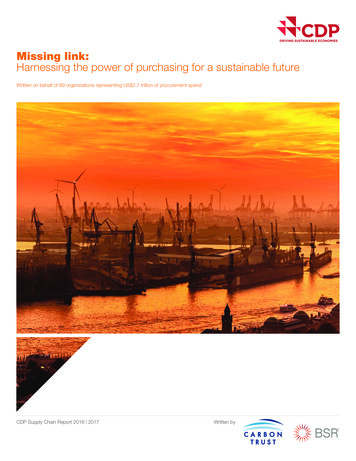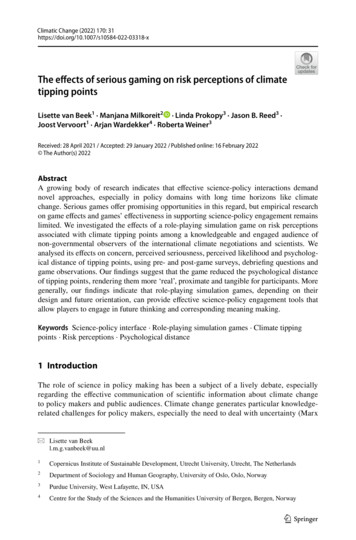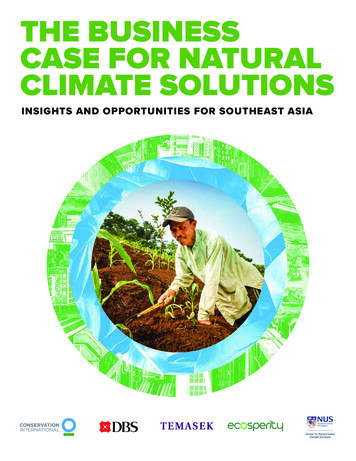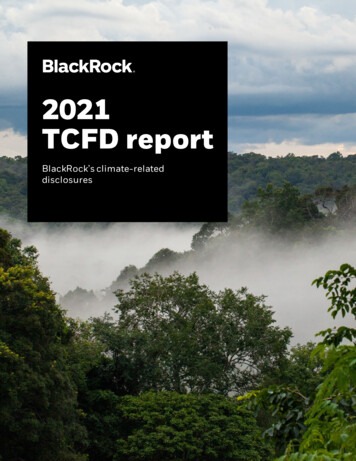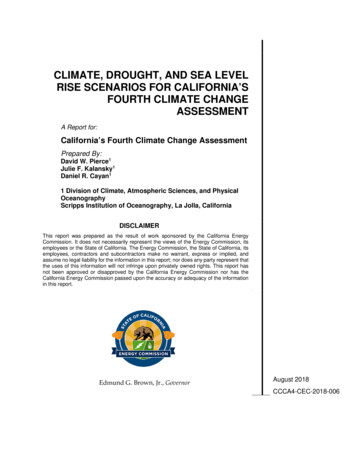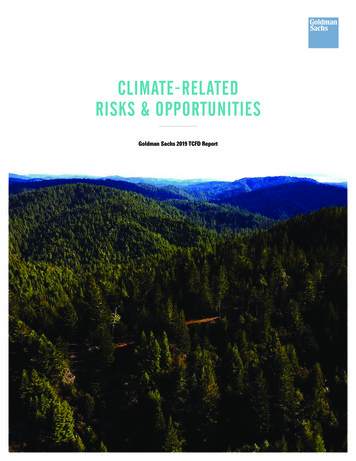
Transcription
CLIMATE - RELATEDRISKS & OPPORTUNITIESGoldman Sachs 2019 TCFD Report
Goldman Sachs 2019 TCFD ReportCONTENTS03 INTRODUCTION04 GOVERNANCE07 STRATEGY — ADVANCING THE OPPORTUNITY07 LEVERAGING THE BREADTH OF OUR BUSINESSES09 PUBLIC POLICY AND INDUSTRY ENGAGEMENT09 OPERATIONAL BEST PRACTICES10 RISK MANAGEMENT11CLIMATE-RISK SCENARIO ANALYSIS12COMPREHENSIVE RISK MANAGEMENT APPROACH14 METRICS AND TARGETS172THE PATH FORWARD
Goldman Sachs 2019 TCFD ReportIntroductionAt Goldman Sachs, we have long recognized the urgency of climate change and have worked toharness market solutions to help address the challenge. We also believe in the importance ofproviding greater transparency on our approach to managing climate-related risks and opportunitiesacross our business and operations.Our inaugural Task Force on Climate-related Financial Disclosure (TCFD) Report provides anoverview of our strategy and approach to climate-related risks and opportunities, including how themanagement and oversight of climate change is integrated across our global business. We also includein this report the initial steps we have undertaken on climate risk scenario analysis to understand theimpacts of both transition risk and physical risk.We recognize that climate change is highly complex and that it is inherently difficult to projecthow related financial risks will materialize across the global economy and markets. In addition,climate scenario analysis is relatively new and evolving rapidly, including with respect to underlyingassumptions, methodologies and data. As such, this report represents the first step in our journeywith the commitment to deepening our understanding of and advancing our approach toclimate-related risks and opportunities over time.Climate-related opportunities and risks manifest in many different ways across our businesses. We see significantopportunities across our financing, investing, asset management, advisory and risk management activities as we work withour clients to help address the climate challenge. At the same time, extreme weather events may disrupt operations oraffect the value of our investments, negative financial impacts on clients from climate change may increase credit risk, andinvolvement in certain industries associated with climate change may pose reputational risk. Given the broad-based impactsof climate change, our cohesive strategy leverages the breadth of our global businesses and the depth of our expertise andinsights to advance climate-related opportunities and to manage climate risk.Our strategy includes a 10-year, 750 billion strategic target to finance, invest and advise clients across nine sustainablegrowth themes, which underlie climate transition and inclusive growth. In addition, given global economies for theforeseeable future are dependent on fossil-based energy and carbon-intensive activities, we are committed to supportingclients across all industries in their efforts to accelerate their climate transition and doing so in an orderly manner. Thisenables us to not only better serve the interests of our clients but also more effectively manage our own risk exposures.In 2019, we strengthened our firmwide efforts by establishing the Sustainable Finance Group (SFG), which reports to theChairman’s Office and is responsible for partnering with our global businesses to deliver leading sustainability expertiseand drive innovative solutions for our clients. This effort is supported by a cross-divisional steering group of senior businessleaders to deliver the breadth of our capabilities.Our strategy also entails understanding and managing climate-related physical, transition and reputational risks. This isembedded both in our comprehensive firmwide risk management approach and more specifically in our climate change riskmanagement framework. In addition to managing risk across our client activities and related balance sheet exposure andreputational risk, we continue to adopt best practices to reduce our own carbon footprint and integrate resiliency into ourglobal operations.Underlying our strategy is an ongoing commitment to deepening our understanding and knowledge of, and progressing ourapproach to, managing climate risks and advancing market opportunities. To that end, we leverage the lessons learned frommanaging our own business and serving our clients, as well as from our external stakeholder engagement, to help inform thework we do and further best practices across the financial services industry and more broadly. We also harness our research insightsand thought leadership to help inform markets and policy, and engage in broader partnerships to further market solutions.3
Goldman Sachs 2019 TCFD ReportGovernanceGiven climate-related impacts manifest across our businesses in different ways, oversight and management of climatechange is integrated into our existing governance structure. This helps to ensure that climate change is strategicallymanaged and the expertise of the firm is both integrated and leveraged across relevant committees and functions.At the most senior level, under the oversight of the Board of Directors and at the direction of senior management, weare committed to serving our clients and delivering robust risk management, including on climate-related opportunities andrisks. Our focus on not only clients but on effective risk and controls is core to our commitment to excellence, as reflectedin our Core Values, Business Principles, and Code of Business Conduct and Ethics.Board of Directors:Our Board of Directors (the “Board”) and its committees are responsible for overseeing the management of the firm’smost significant risks, placing significant focus on reputational risk and management’s operation of the firm for thelong term. The Board’s Public Responsibilities Committee (PRC) provides oversight of our firmwide sustainability strategy andsustainability issues affecting the firm, including with respect to climate change. As part of its oversight, the PRCreceives updates on the firm’s Environmental Policy Framework (EPF), which serves as an ambitious roadmap for howwe seek to leverage our people, capital and ideas to address critical environmental challenges and promote sustainableeconomic growth across our businesses. The EPF also includes environmental and social risk guidelines, including forcarbon-intensive sectors. The Risk Committee of the Board oversees the firm’s overall risk-taking tolerance and management of financial and nonfinancial risks, including climate risk. In this respect, the Risk Committee provides oversight of the firm’s Risk AppetiteStatement (RAS), which conveys the firm’s view of its risk culture, risk appetite and risk management philosophies,including those related to climate change.4
Goldman Sachs 2019 TCFD ReportFirmwide Committees:In addition to Board-level oversight, we have a series of firm-level committees with risk management mandates that haveoversight or decision-making responsibilities for risk management activities and environmental, social and governance(ESG) issues, including relevant climate change considerations. At a firmwide level, the Enterprise Risk Committeeoversees all of our financial and non-financial risks, including climate-related risk.In addition, we have firm-level risk committees that provide oversight for different businesses, activities, products, regionsand entities. For example, the Firmwide Capital Committee, which approves and oversees debt-related transactions,including balance sheet-related commitments, integrates relevant climate-related considerations. For our own operations,the Firmwide Resilience and Operational Risk Committee provides oversight over operational risk and resiliency,including physical risks relating to climate change.All of our committees have responsibility for considering the reputational impact of transactions and activities that theyreview. The Firmwide Reputational Risk Committee provides oversight over transactions that may have heightenedreputational risk, which includes considerations relating to environmental and social factors, such as climate-relatedreputational risk.Below are relevant key committees.5CommitteeDescriptionManagement CommitteeOversees global activities directly and through authority delegated to committees it has established.This committee consists of our most senior leaders.Firmwide Enterprise Risk CommitteeOversees all of our financial and non-financial risks as well as the ongoing review, approval andmonitoring of our enterprise risk management framework.Firmwide Reputational Risk CommitteeAssesses reputational risks arising from transactions that have been identified as having potentialheightened reputational risk.Firmwide Capital CommitteeApproves and oversees debt-related transactions and ensures that business, reputational andsuitability standards for underwritings and capital commitments are maintained on a global basis.Firmwide Commitments CommitteeApproves and oversees underwriting and distribution activities with respect to equity and equity-relatedproducts, and sets and maintains policies and procedures designed to ensure that legal, reputational,regulatory and business standards are maintained on a global basis.Firmwide Investment Policy CommitteeReviews, approves, sets policies and oversees certain principal investments, including review ofrisk management and controls for these types of investments.Firmwide Resilience and OperationalRisk CommitteeOversees operational risk, and ensures our business and operational resilience.Physical Commodity Review CommitteeMaintains a consistent approach to evaluating risks associated with engaging in, investing in, or thefinancing of physical commodity activities that may have an impact on the environment or humanhealth and safety.
Goldman Sachs 2019 TCFD ReportRelevant Divisions /Functions:Climate change risks and opportunities are integrated across relevant areas of our businesses. As part of theirresponsibilities, the following three divisions/functions play a specific role in managing climate-related risks andopportunities and ensuring that we continue to advance our insights and expertise. Risk Division: The Risk Division has a range of climate-related functions, working with business units and controlgroups on risk identification and stress-testing activities. The division also assesses financial risks of counterparties andtransactions, including credit risk. In addition, the division oversees the firm’s operational resilience framework, whichfactors in potential impacts from climate-related risks on the firm’s activities. Executive Office (EO) — Sustainable Finance Group (SFG): The SFG, which reports to the Office of the Chairman,is responsible for partnering with the firm’s global businesses to deliver leading sustainability expertise and capabilitiesto our clients and drive innovative market solutions that advance climate transition and inclusive growth. SFG alsoengages with the firm’s stakeholders to stay abreast of and, where relevant, help inform sustainable finance and climatechange-related policy. In addition, SFG works with the Business Intelligence Group, the Risk Division and the businessunits on firmwide environmental and social risk management and related guidelines. By being part of the EO andworking across all of the global businesses, clients and stakeholders, SFG brings together the breadth of our knowledgeand capabilities and ensures we continue to deliver our insights and expertise. S ervices Division — Corporate Services & Real Estate (CSRE), Crisis Management Group: The Services Divisionprovides essential commercial advisory and management services to enable the firm’s flow of business, driveoperational efficiency, manage risk and deliver the world’s best work experience and environment. CSRE partnerswith the Crisis Management Group to assess and plan for near- and long-term climate-related risks across our operationsthrough infrastructure and business continuity reviews of the firm’s global corporate real estate portfolio. This enablesclimate-related risk to be actively monitored and threats to be minimized to ensure the firm operates continuouslythrough and swiftly recovers from any business disruption.Cross-Divisional Groups:In addition to the specific divisions/functions, we have established cross-divisional steering groups to more effectivelyleverage the firm’s capabilities and activities and to ensure a holistic, firmwide approach to managing climate-related risksand opportunities. These include: S ustainable Finance Steering Group: Comprised of senior leaders responsible for integrating sustainability expertiseacross our divisions and bringing our capabilities together across the firm. The group convenes periodically to guideand support firmwide sustainable finance efforts relating to key strategic initiatives and client delivery, while providingleadership for cross-divisional work streams and new opportunities. Climate Change Risk Steering Group: Comprised of representatives from the Risk Division, Services Division and theExecutive Office that are responsible for evaluating climate-related scenario analysis and the broader TCFD assessment.This group also reviews the implementation of the strategic climate risk management approach outlined in this report tostrengthen climate-related financial risk integration across our businesses and practices.6
Goldman Sachs 2019 TCFD ReportStrategy — Advancing the OpportunityAs markets and client activity shift in response to climate change, we have a substantial opportunity to harness innovativecapital market tools and partner with our clients to help accelerate their climate transition. In addition, our ability toleverage the breadth of our capabilities, our commitment to continuously deepening our expertise and refining our insights,and applying these both across our own operations and in serving our clients’ needs, ensures we stay front-footed inintegrating climate change opportunities and risks.In December 2019, we announced a new sustainable finance target of 750 billion of financing, investing and advisoryactivity by 2030. This target encompasses activities across nine strategic growth themes, which are rooted in 10 yearsof market research, focused on climate transition and inclusive growth. Areas of focus in our climate transition activityinclude clean energy, sustainable transport, sustainable food and agriculture, waste and material, as well as ecosystemservices — areas where we can help scale technology and solutions through greater and more efficient capitaldeployment. In addition to this target, we have expanded our work with clients more broadly to help them with theirclimate transition and in ensuring sustainable growth more broadly, and we are harnessing innovative market solutionsto help clients better manage and adapt to climate risks.Leveraging the Breadth of Our BusinessesWe leverage our capabilities across financing, advisory, risk management solutions, asset management and investingto help our clients achieve their climate-related goals, facilitate the low-carbon transition, and strengthen adaptation andresiliency. The following table provides an overview.7
Goldman Sachs 2019 TCFD ReportBusiness ActivityInvestment Banking: Our Investment Banking franchise is wellpositioned to support clients with climate transition strategiesand to assist both incumbents and new companies to innovate andgrow. Goldman Sachs is a leading global M&A advisor and isregularly recognized for our leadership in clean energy financingand innovative sustainability financing solutions.Key Examples Deployed more than 115 billion toward clean energy financingand investing since 2006 Active underwriter of catastrophe bonds, helping raise more than 20 billion to manage weather-related events since 2006 Underwrote nearly 59 billion in green, social and sustainabilitybonds since 2014 Advising clients on low-carbon transition and sustainablegrowth strategies Merchant Banking has a track record of investing in renewableenergy and clean technology solutions globallyAsset Management: Goldman Sachs has one of the leadinginvesting and asset management franchises across the breadth ofasset classes and with global scale. A key area of strategic focusis ESG and impact investing as well as investing in climate transitionand sustainable growth themes.Consumer & Wealth Management: ESG and impact investing is a fastgrowing area for our consumer and wealth management businesses,with investment strategies across a number of innovative environmentaland social themes.Global Markets: Goldman Sachs facilitates the efficient developmentof carbon and other climate-related commodity markets. Our GlobalMarkets business has been a leading participant in the global energymarkets for over 20 years and is active in both carbon and renewableenergy markets, helping developers and corporates scale solutionsand mitigate risks. Goldman Sachs Asset Management (GSAM) has 74 billionin ESG and impact investing assets under supervision (AUS)as of December 2019 GSAM recognizes that environmental factors, including climate change,can affect investment performance and considers it an engagementpriority. It has supported shareholder proposals related to climatechange disclosures 60 percent of the time and shareholder proposalsrelated to a 2-degree scenario analysis 100 percent of the time1 Provides innovative client solutions across portfolios, investmentstrategies and products, including customizable passive ESGoptions, ESG structured notes, and renewable funds and otherclimate offerings Supported over 1.5 billion of new build renewable investmentsthrough 1,250 MW of renewable offtake transactions since 2018 Market maker in carbon credits, participating in the EU EmissionTrading Scheme from its inception and in the California carbon marketGSAM Stewardship Report, 2019.1Global Markets and our other businesses are supported by our Global Investment Research (GIR) division. GIR is aleading provider of ESG thought leadership with a dedicated global SUSTAIN team. SUSTAIN research includes an ESGframework through which to evaluate corporate ESG engagement, and investing roadmaps and thematic pieces on therisks and opportunities associated with sustainability. Climate change has been a growing area of research focus, withtopics such as carbon pricing, climate resiliency of cities, climate strategies of Big Oil companies, and investing in climatesolutions. Read the reports here.For additional details, please refer to our 2019 Sustainability Report.8
Goldman Sachs 2019 TCFD ReportPublic Policy and Industry EngagementWe continue to work with other companies, nonprofit organizations and other stakeholders to share insights andfurther best practices that advance sustainability and climate transition. In addition, where appropriate, we advocate foreffective climate policy to help inform ways to advance market solutions that can help address climate change.The following are examples. Paris Climate Agreement: We have actively engaged in making the business case for global climate action, includingsupport for the 2015 UNFCCC Paris Agreement. We were one of the first US companies to commit to the White HouseAmerican Business Act on Climate Pledge in 2015; we signed an open letter alongside 29 other CEOs in 2017 to supportthe US staying in the Paris Agreement; and more recently, we were part of a group of 80 CEOs and labour leadersreiterating our support that staying in the Paris Agreement will strengthen US competitiveness in global markets. Carbon pricing: We have long articulated the need for governments to provide transparency around the costs ofgreenhouse gas (GHG) emissions and to create long-term value for GHG emissions reductions. More recently, in aDecember 2019 editorial, our CEO David Solomon underscored the urgency and business case for climate transition andcalled for governments to put a price on carbon. In February 2020, Goldman Sachs, alongside more than 25 companies,joined as a founding member of the Climate Leadership Council (CLC) to support a revenue-neutral carbon fee anddividend plan for the US. C atalyzing climate finance: We have continued to leverage our market insights to help catalyze greater capital flowsto address climate change. In 2019, we joined the CEO-led Climate Finance Leadership Initiative (CFLI) as one ofseven founding members, to support greater mobilization of climate finance flows. In September 2019, CFLI deliveredits Financing the Low-Carbon Future report to the UN to inform ways to further mobilize private climate finance at thescale and speed needed to support a rapid and orderly transition to a low-carbon global economy. I ntegrating climate-related risks and opportunities: In 2019, Goldman Sachs Asset Management teamed up with aselect group of other leading asset managers to advance climate-related investment among national sovereign wealthfunds (SWFs). Known as the One Planet Asset Managers Initiative, this collaboration supports the efforts of the OnePlanet SWF Working Group, composed of leading sovereign wealth funds, to drive a deeper consideration of the impactof climate change on investment portfolios.Operational Best PracticesIn addition to harnessing the breadth of our businesses to help our clients with their climate transition and scalinginnovative market solutions to address climate change, Goldman Sachs is committed to being a leader in implementingsustainability practices that minimize the impact of our global operations on the environment. For example, we have beencarbon neutral from 2015 onward across our global direct Scope 1, indirect (market-based) Scope 2, and Scope 3 businesstravel emissions. Additionally, by year-end 2020, we are committed to procuring 100% renewable energy and attainingLEED Gold or equivalent for 70 percent of our global corporate real estate footprint.In December 2019, we established a new suite of 2025 operational sustainability goals with a focus on strategic,collaborative partnerships that drive market transformation, as outlined in our Sustainability Report. The firm has been amember of RE100 since 2015 and recently joined additional initiatives EV100 and EP100 with ambitious commitmentsto electrify transport and deploy smarter energy use — making us the first US company to become a member of all threeof The Climate Group’s global corporate leadership initiatives to accelerate the clean energy transition.9
Goldman Sachs 2019 TCFD ReportRisk ManagementBecause we are a global financial services firm with clients operating in diverse sectors and offices across manycountries, climate change presents a range of potential risk considerations across our businesses and activities. Forexample, climate change may cause extreme weather events that disrupt operations at one or more of our primarylocations, which may negatively affect our ability to service and interact with our clients and also may adversely affect thevalue of our investments. Climate change may also have a negative impact on the financial condition of our clients, whichmay decrease cash flows from those clients and increase the credit risk associated with loans and other credit exposuresto these clients. Additionally, our reputation may be impacted as a result of our involvement, or our clients’ involvement,in certain industries or projects associated with climate change.The table below provides a description of the range of climate-related risk considerations.10RiskDescriptionMarketPhysical and transition risk could impact the value of assets in which we make markets and invest.CreditCounterparty financial performance and collateral values could deteriorate as the transitionand physical impacts of climate change manifest over time.LiquidityClimate-related disruptions could impact the availability and accessibility of capital in markets forcertain sectors and securities.OperationalIncreased severity of climate-related events could impact our office locations and disrupt oursystems, people and processes across our global footprint.ReputationGrowing stakeholder focus on corporate action to meet emissions reduction targets can resultin increased reputational risk and reduced client and employee loyalty, investor divestment andimpacts to client activity.LegalClimate-related disclosures are increasingly important and climate-related litigation could also resultfrom stranded assets, acute climate events or resulting market price declines.
Goldman Sachs 2019 TCFD ReportClimate-Risk Scenario AnalysisOur overall business structure, strategy and comprehensive risk management provide a strong foundation formanaging and mitigating these potential risks. However, climate change is highly complex and non-linear, with manyuncertainties. In addition, new data, tools, and expectations are continuously evolving. As such, we have a climatechange risk management framework, which includes stress testing based on an initial set of scenarios. As part ofongoing implementation, we are undertaking further refinement of the scenarios with the goal of improving their riskmanagement benefit.As a global financial institution, we use a variety of stress-testing techniques to calculate the potential impact of a widerange of potential market moves. We perform stress testing on a regular basis to ensure a comprehensive analysisof our vulnerabilities and idiosyncratic risks in anticipation of market events or conditions, which include climateconsiderations. For climate stress testing, we perform both (i) transition risk stress tests on the value of our balancesheet-related equity and credit assets, and (ii) physical risk stress tests on our global properties. The following is whatwe have initially undertaken:(i) Transition Risk Stress TestTransition risk arises from changes to policy, technology and consumer preferences over time that reduce reliance oncarbon-intensive products and services. The composition of industries, particularly in the energy sector, will change asa result of compliance with climate policy changes such as the implementation of the Paris Agreement. Since individualcountries will implement decarbonization policies in different ways, changes to industries will also depend on where theyare located and how the policies evolve over time. Climate policy changes introduce financial risks to financial institutionsthat may own or finance companies whose value could be affected. To measure these risks, we perform transition riskstress testing.Currently, we perform transition risk stress tests under two scenarios: 1) a scenario in which the Paris Agreement is fullyimplemented by all countries; and 2) a scenario in which the Paris Agreement is partially implemented in line with currentpolicy plans. In implementing each scenario, we assume that a credible policy change is announced and that the marketconsequently adjusts credit ratings and prices of affected companies and trades. In each stress test, we estimate thechange in credit ratings that would result from each policy change as well as the changes in equity and credit prices thatare consistent with those credit rating changes. We then reprice all affected assets on our balance sheet to measure thetotal change in value that would result under each scenario.(ii) Physical Risk Stress TestPhysical risk arises from changes to the environment that are produced directly by the continuing concentration of GHGsin the atmosphere and the consequent increases in temperature, precipitation, sea level and other environmental factors.Physical changes in the environment may affect the value of properties directly; an increase in sea level, coupled withmore extreme precipitation and hurricanes, would affect the value of coastal properties, for example. But physical risksmay also influence the value of assets indirectly by reducing local economic growth, worsening health or lowering laborproductivity. The magnitude of physical risks that manifest is linked to transition scenarios, since GHG emissions and theirresulting impacts will be determined by policy-driven mitigation measures.In our physical stress test, we examine the effect of heat stress, water stress, extreme precipitation, sea level rise, andflooding on our properties. The climate policy that we assume in our stress test is a high-emissions policy. We assume thatthe concentration of GHGs increases even more than expected under current policies and that therefore temperature andother environmental risks worsen relative to business-as-usual expectations.11
Goldman Sachs 2019 TCFD Report(iii) Next StepsThese initial stress tests were helpful in understanding relative sensitivities and providing a starting point for furtherrefining the analysis. To that end, we are working to enhance our transition risk and physical risk stress tests along anumber of dimensions in order to improve their decision usefulness. In our transition risk stress test, we are examininghow to increase its flexibility so that we can run a wider range of scenarios that incorporate more varied policy changes.Similarly, in our physical risk stress tests, we are exploring how we might incorporate a wider range of policy changes,such as full adherence to the Paris Agreement. We are also considering how to add more physical risks to our physicalstress test, such as wildfires, and how to better estimate the effects of physical risks on asset values. More broadly, weare investigating whether the transition risk and physical risk stress tests should be unified or whether it would be morebeneficial to keep them separate.Comprehensive Risk Management ApproachBusiness Structure and Strategy:As a global financial institution with a diverse set of businesses and clients, our business structure and strategy help usmanage overall climate-related risks and in
11CLIMATE-RISK SCENARIO ANALYSIS 12COMPREHENSIVE RISK MANAGEMENT APPROACH 14 METRICS AND TARGETS 17 THE PATH FORWARD CONTENTS. Goldman Sachs 2019 TCFD Report 3 . Oversees operational risk, and ensures our business and operational resilience. Physical Commodity Review Committee
